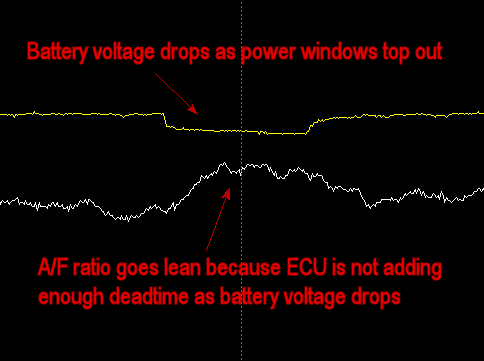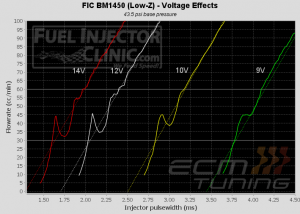Table of Contents
Injector Data - Voltage
Fuel flow rate through an injector is affected by a number of different things. This page focuses on the effects of voltage across the injector. Of all the things that might affect injector flow rate, particularly at idle and cruise pulse widths, voltage is one of the most influential.
Example
The effect of varying voltage across an injector is easy for us to imagine because (1) the effect is pretty dramatic and (2) we can often demonstrate it ourselves while sitting in the car. The image below shows one simple example of topping out the power windows. But voltage is constantly being influenced by all sorts of things (alternator output which can be influenced by engine speed or fans coming on or off, etc.), so the effect is actually pretty common in the real world.
So your ECU really has to adjust for this varying voltage in some way. It can't just turn the injectors on for 3 ms and always expect to get the same amount of fuel. As we'll see in the next section, a 3 ms pulse at 9v might produce no flow at all while the same 3 ms pulse at 14v might produce 200 cc/min of fuel or more! (NOTE: The cc/min unit of measure is really inappropriate in this example. We should say something like “uL/stroke”, but since few people outside the realm of injector academics uses that, we try to convert it to something more familiar by assuming some common engine speed. Here, for example, and on most of our webpages, we're using 6000 RPM to convert uL/stroke to cc/min.)
Data
To illustrate this difference, we used a set of FIC BM1450s to run a series of test at low pulsewidths typical for idle and cruise operation on a 4-cylinder, 2.0l engine. The results are show below.
Obviously, this effect is huge. If the ECU calculates that it needs roughly 50 cc/min of fuel flow (for example), it would need to hold the injector open for 4 ms at 9 volt vs. about 2.3 ms at 12 volt. That's a really big difference and clearly illustrates why it's critical for smooth operation to get your voltage table set up correctly.

